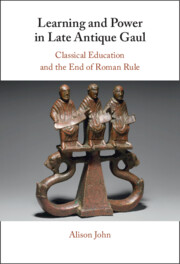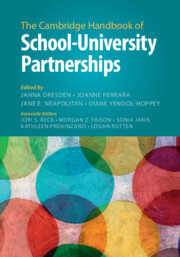Refine search
Actions for selected content:
124 results
Chapter 1 - Classical Education in the Late Roman World
-
- Book:
- Learning and Power in Late Antique Gaul
- Published online:
- 22 December 2025
- Print publication:
- 22 January 2026, pp 23-49
-
- Chapter
- Export citation
Chapter 4 - Education in Society and Culture
-
- Book:
- Learning and Power in Late Antique Gaul
- Published online:
- 22 December 2025
- Print publication:
- 22 January 2026, pp 132-160
-
- Chapter
- Export citation
6 - Applying Corpus Research Indirectly to Language Teaching Materials and Assessment Development
-
-
- Book:
- Applications of Corpus Linguistics
- Print publication:
- 22 January 2026, pp 105-129
-
- Chapter
- Export citation
Chapter 3 - The Relationship between Education and Power
-
- Book:
- Learning and Power in Late Antique Gaul
- Published online:
- 22 December 2025
- Print publication:
- 22 January 2026, pp 90-131
-
- Chapter
- Export citation
Introduction
-
- Book:
- Learning and Power in Late Antique Gaul
- Published online:
- 22 December 2025
- Print publication:
- 22 January 2026, pp 1-22
-
- Chapter
- Export citation

Learning and Power in Late Antique Gaul
- Classical Education and the End of Roman Rule
-
- Published online:
- 22 December 2025
- Print publication:
- 22 January 2026
Chapter 12 - Being a play activist and play leader
-
- Book:
- Play in the Early Years
- Published online:
- 12 December 2025
- Print publication:
- 11 December 2025, pp 248-262
-
- Chapter
- Export citation
Chapter 5 - Playing in schools
-
- Book:
- Play in the Early Years
- Published online:
- 12 December 2025
- Print publication:
- 11 December 2025, pp 88-105
-
- Chapter
- Export citation
Chapter 6 - Lenses on play: Post-structuralist and feminist analyses of children’s play
-
- Book:
- Play in the Early Years
- Published online:
- 12 December 2025
- Print publication:
- 11 December 2025, pp 106-124
-
- Chapter
- Export citation
19 - Inspiring Creativity in Others
- from Part V - Reflections
-
- Book:
- The Artist's Life
- Published online:
- 04 November 2025
- Print publication:
- 20 November 2025, pp 137-146
-
- Chapter
- Export citation
5 - School Struggles
- from Part I - Childhood
-
- Book:
- The Artist's Life
- Published online:
- 04 November 2025
- Print publication:
- 20 November 2025, pp 29-34
-
- Chapter
- Export citation
4 - School through an Artist’s Eyes
- from Part I - Childhood
-
- Book:
- The Artist's Life
- Published online:
- 04 November 2025
- Print publication:
- 20 November 2025, pp 23-28
-
- Chapter
- Export citation
7 - Tracing Liberal Democracy’s Influence on Educational Policy
- from Part III - Testing Underlying Assumptions
-
- Book:
- Faith in Democracy
- Published online:
- 23 October 2025
- Print publication:
- 06 November 2025, pp 157-198
-
- Chapter
- Export citation

The Cambridge Handbook of School–University Partnerships
-
- Published online:
- 05 November 2025
- Print publication:
- 07 August 2025
Evaluating “Conmigo, Contigo, Con Todo”: Effects of a community mental health initiative on Afro-Colombian teachers
-
- Journal:
- Cambridge Prisms: Global Mental Health / Volume 12 / 2025
- Published online by Cambridge University Press:
- 16 October 2025, e117
-
- Article
-
- You have access
- Open access
- HTML
- Export citation
Water Sustainability among Secondary Education Teachers: Perspectives from Two Hispanic Cities
-
- Journal:
- Australian Journal of Environmental Education , First View
- Published online by Cambridge University Press:
- 01 October 2025, pp. 1-16
-
- Article
-
- You have access
- Open access
- HTML
- Export citation
Chapter 10 - Classroom management
- from Part III - Professional practice
-
-
- Book:
- Learning to Teach in a New Era
- Published online:
- 04 October 2025
- Print publication:
- 25 September 2025, pp 338-363
-
- Chapter
- Export citation
Chapter 8 - Aboriginal and Torres Strait Islander education
- from Part III - Professional practice
-
-
- Book:
- Learning to Teach in a New Era
- Published online:
- 04 October 2025
- Print publication:
- 25 September 2025, pp 269-302
-
- Chapter
- Export citation
Bad Grammar: Teachers, Crime, and the Law in Late Medieval and Early Modern England
-
- Journal:
- History of Education Quarterly / Volume 65 / Issue 4 / November 2025
- Published online by Cambridge University Press:
- 23 September 2025, pp. 517-535
- Print publication:
- November 2025
-
- Article
-
- You have access
- HTML
- Export citation
1 - Rupturing Patriarchy through the Class Struggle, 1965–1980
-
- Book:
- The Making of Revolutionary Feminism in El Salvador
- Published online:
- 28 October 2025
- Print publication:
- 18 September 2025, pp 52-106
-
- Chapter
- Export citation
